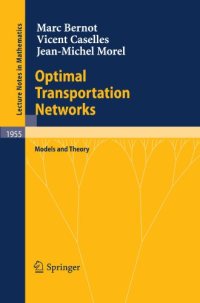
Ebook: Optimal transportation networks: Models and theory
- Genre: Computers // Networking
- Tags: Calculus of Variations and Optimal Control, Optimization, Operations Research Mathematical Programming, Engineering Economics Organization Logistics Marketing, Operations Research/Decision Theory, Applications of Mathematics
- Series: Lecture Notes in Mathematics 1955
- Year: 2009
- Publisher: Springer-Verlag Berlin Heidelberg
- Edition: 1
- Language: English
- pdf
The transportation problem can be formalized as the problem of finding the optimal way to transport a given measure into another with the same mass. In contrast to the Monge-Kantorovitch problem, recent approaches model the branched structure of such supply networks as minima of an energy functional whose essential feature is to favour wide roads. Such a branched structure is observable in ground transportation networks, in draining and irrigation systems, in electrical power supply systems and in natural counterparts such as blood vessels or the branches of trees.
These lectures provide mathematical proof of several existence, structure and regularity properties empirically observed in transportation networks. The link with previous discrete physical models of irrigation and erosion models in geomorphology and with discrete telecommunication and transportation models is discussed. It will be mathematically proven that the majority fit in the simple model sketched in this volume.
The transportation problem can be formalized as the problem of finding the optimal way to transport a given measure into another with the same mass. In contrast to the Monge-Kantorovitch problem, recent approaches model the branched structure of such supply networks as minima of an energy functional whose essential feature is to favour wide roads. Such a branched structure is observable in ground transportation networks, in draining and irrigation systems, in electrical power supply systems, and in natural counterparts such as blood vessels or the branches of trees.
These lectures provide mathematical proof of several existence, structure and regularity properties, empirically observed in transportation networks. The link with previous discrete physical models of irrigation and erosion models in geomorphology and with discrete telecommunication and transportation models is discussed. It will be mathematically proven that the majority fit in the simple model sketched in this volume.